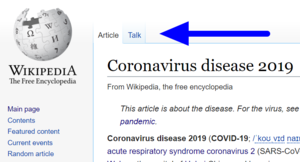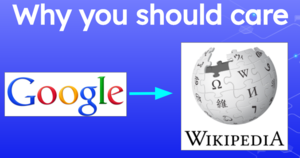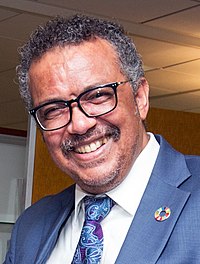Wikipedia:Wikipedia Signpost/2020-03-29/Special report
Wikipedia on COVID-19: what we publish and why it matters

Wikipedia is among the most requested, published, accessed, and consulted sources of information on coronavirus disease 2019, also called COVID-19. Responsible media planning to communicate general-interest information for COVID-19 or any future crisis includes recognition of Wikipedia's position in the global media environment, what Wikipedia is, and why Wikipedia matters.
Wikipedia's volunteer editors ask the world to identify the most reliable authorities who have published the best information. With these sources available, wiki editors invite everyone to join them in summarizing and citing this content to develop the Wikipedia articles which people read. In this way, readers everywhere get access to information and a public and permanently archived editorial process which anyone can join, review, and critique. Anyone in the world who knows of any expert organization with general reference information to share in any language can encourage that organization to take advantage of Wikipedia's broad reach to share their content. Otherwise, any supporters of an organization's good content can summarize and cite that information themselves in Wikipedia.
Wikipedia is the world's central general information resource
Wikipedia is popular because Wikipedia articles have a high rank in Internet search results. Many journalists, policymakers, health commentators, and medical students read Wikipedia articles directly because they use Wikipedia as a starting point to orient themselves to new topics. Many physicians have patients who read Wikipedia, and consequently, physicians read Wikipedia to understand what information is in public circulation. Because Wikipedia influences the media environment in every field of expertise, any organization which seeks to share information broadly with the public is a particular stakeholder in the scope and quality of Wikipedia content. Wikipedia relies on universities, research institutes, and cultural partners to publish excellent information which Wikipedia can cite, and those organizations in turn may take advantage of Wikipedia's media reach to accomplish their own communication goals for distributing and disseminating their information to the largest audience which the Internet has to offer.
The audience who reads Wikipedia are the people who use search engines including Google, Bing, and DuckDuckGo. More recently, virtual assistants including Google Assistant, Siri, and Amazon Alexa have been answering questions using Wikipedia and Wikidata content. Third-party media through platforms including YouTube and Facebook both direct people to Wikipedia and serve the Wikipedia content to users in their platform. Wikipedia is central to most everyone's experience of using the Internet. Wikipedia has billions of readers,[a] so virtually everyone in the world is within Wikipedia's media influence.
Wikipedia's traffic reports are available to everyone
Articles for the COVID-19 pandemic in English, 中文, فارسی, italiano, русский, हिन्दी, 한국어 and more than one hundred other languages are all part of Wikipedia as a multilingual hub and center for establishing global census in information sharing. As Wikipedia is a free and open project, the traffic report for every Wikipedia article in every language is free and open data for everyone to examine. These reports can help organizations to evaluate the usefulness of publishing in Wikipedia. Conventional communication investment assumes that an expert organization will be able to produce quality information at low cost, but then pay for expensive advertising and outreach to drive readers to their website or insert their content as advertising into existing reader communication channels. With Wikipedia, the audience reach is predictable as the people who use Internet search for gathering information. Consequently, Wikipedia's major challenge is in identifying and acquiring content and collaborations with organizations which will share it. Any organization which is engaged in global-scale public benefit communication, such as for global health, can use Wikipedia traffic reports to compare the pageviews to existing Wikipedia articles with their other options through other media channels.
Three popular Wikipedia audience metrics reports are "Pageviews", which is the traffic to a single article in a single language; "Massviews", which is the traffic to any number of articles in one language; and "Langviews", which is the traffic to a single article in every available Wikipedia language version. All of these are variations of the Pageviews Analysis tool, which itself is a part of the broader practice of wiki traffic reporting.
Three main COVID-19 articles: disease, virus, and pandemic
Wikipedia's most popular articles on COVID-19 are for the disease in the human body, Coronavirus disease 2019; the virus, Severe acute respiratory syndrome coronavirus 2; and the outbreak, 2019–20 coronavirus pandemic. This scope of coverage is already highly unusual, as writing about the disease requires careful summary of medical articles, and writing about the virus requires explaining topics in computational biology to the general public; and a narrative of the pandemic comes from people in every country collaborating to compile their culture's best reports and journalism. While many specialized publications may have deep coverage of one of these, and journalism gives overviews of these, Wikipedia is an unprecedented mix of both. In Wikipedia, the target is to present articles in specialized fields which are both accurate enough to be useful for experts to use, and accessible enough for any curious typical person to gain enough understanding to inform their own decisions – and to edit related Wikipedia articles.
Consider the Wikipedia article on the virus. Wikipedia is uncommon or alone among all popular media sources for its attempt to summarize and cite academic journal articles in the scientific field of virology, molecular biology, and genetics. Of the 90 sources which Wikipedia editors currently cite in the article, 40 are to materials published in academic journals. The Wikipedia community's intent here is to bring the best available information to the public when people ask for it, and in the case of COVID-19, people who have never before asked for information from academic journals are getting science articles on demand right here. Readers can even click through and read those research articles if they are available to the public.
Subtopics: locations, people, timelines, and social issues
Almost every country in the world has its own national story about how COVID-19 changed the lives of its people and the activities of its society. Wikipedia has individual articles to present and preserve these stories for more than 200 countries and regions. These various articles seek to collect and cite original local media sources in local languages wherever possible so that the coverage for a particular place matches the reporting and concerns of the people who had the local experiences. Each regional article is also a point of connection by means of which Wikipedia editors organize multilingual collaboration. While English Wikipedia is the most popular language version globally, for any given language community, people routinely choose to read and edit the specific language versions of Wikipedia for their own languages. Wikipedia editors who can translate two or more languages routinely carry information across language sources into other languages of Wikipedia. A common motivation for editors doing this is to share the concerns and wishes of their culture with a wider global audience.
The most popular single article type in Wikipedia is the biography. When a person has been the subject of media attention, then Wikipedia editors can cite those media sources and create a biography. Wikipedia's curated COVID-19 collection of biographies includes prominent researchers and scientists, the politicians who are issuing policy decisions, and people who gain attention for their COVID-19 infections. In many cases, these articles began in the local language version Wikipedia of the subject's country of origin, but once anywhere in Wikipedia, editors will translate these biographies into local languages.
English Wikipedia editors deem more than 400 articles worth managing in the COVID-19 content portfolio. Other popular topics of articles about COVID-19 include compiling timelines, tracking social issues such as the pandemic's socio-economic impact or xenophobia, and countering misinformation, along with various medical concepts like COVID-19 testing or efforts towards a COVID-19 vaccine.
Illustrations and multimedia for every topic
Wikipedia is more than a plain text encyclopedia: some editors volunteer their time curating the text, while others perform other necessary functions such as illustration and photography, copyediting, community organizing, data science, quality control, and administrative tasks.
For supplementary media to illustrate their articles, the encyclopedia writers look to Wikimedia Commons, which is the Wikimedia sister project curating non-text media such as the photos which illustrate Wikipedia's text encyclopedia articles. The typical source of photography is the volunteer photographer who takes a picture wherever they are in the world and shares it in the Wikimedia platform with a free and open copyright license for anyone to reuse. Photography itself has its own subcultures, and for example, there is a culture in photography of people who like to take photos of ships, landscapes, and people.
Part of the COVID-19 story is how cruise ships became a vector for spreading infection, and a natural experiment at that. Many people find huge vessels to be interesting, so in advance of COVID-19, Wikipedia already had articles with photographs of the cruise ships which were the sites of infection. For example, in March 2020, the cruise ship Diamond Princess had passengers who died of COVID-19. A Wikipedia editor created the article for this ship in 2005 and people have been photographing and sharing photos of this ship for years in many countries as documented in a Wikimedia Commons gallery. Wikipedia is the only media outlet which prepared for COVID-19 by documenting and photographing cruise ships 10 years before the outbreak, and Wikipedians also solicited and received feedback from nautical experts to manage these articles through WikiProject Ships and related activities like a three-day workshop dedicated to writing German Wikipedia articles about ships and marine culture.
The source of portraits is typically an encounter between a Wikipedia editor and a person of interest. The United States is one of only a few nations that are applying public domain copyright status to its output, which is why Wikimedia curators can re-purpose some medical illustrations from the Centers for Disease Control as Wikipedia illustrations. Many sincere graphic designers also assist Wikipedia by attaching free and open copyright licenses to their illustrations of abstract concepts, which would be challenging to portray otherwise.
Ebola in 2013, Zika in 2016, and Wikidata every day
Wikidata is the structured data knowledge base which complements Wikipedia and which, like Wikipedia, anyone can edit. Whereas Wikipedia presents general reference prose, Wikidata can answer questions about the articles in Wikipedia as a whole. For example, Wikidata can quickly generate the list of people who have died of COVID-19 and also have a biography in any language of Wikipedia. With this aid, people can create a Wikipedia article in any language reporting a death in any country, and everyone else in the world can gain some knowledge of it or translate more information.
Every article in Wikipedia gets a corresponding Wikidata item. From this point, Wikidata is the hub of Wikimedia cataloging, organization, and query across all languages. For example, Wikidata labels the COVID-19 pandemic (Q81068910) as an "instance of a pandemic". A "pandemic" is a subclass of disaster, so now COVID-19 outbreaks will appear – whenever and wherever someone includes them in Wikipedia/Wikidata – on the automatically generated maps and timelines of WikiProject Humanitarian Wikidata. The wiki community logs both present and historical outbreaks, wildfires, plane crashes, and mass shootings in Wikidata for anyone to query by disaster type, location, number of people affected, or any other descriptor of the sort which wiki editors would use in writing about an occurrence.
Much information about disease outbreaks comes from academic journals, which are the scholarly publications of researchers. Prior to Wikipedia, most people who read academic journals were university professors and students or experts in a field. Since the establishment of Wikipedia, the wiki community has taught the world more broadly that people who make claims should cite reliable sources, and that informed citizens can establish consensus to distinguish objective truth versus fake news, and that instead of anyone citing Wikipedia, fact-checkers should inspect and cite the original sources which Wikipedia itself cites. Wikidata catalogs the source metadata of citations in the WikiCite project. Once these citations are available in Wikidata format, then anyone can query these publications to find the best sources to cite in Wikipedia or for research in any context. Anyone who wishes to review the WikiCite collection of information may review and curate COVID-19 information about the disease, the pandemic, and the virus.
The encyclopedia which anyone can edit
The Wikimedia community of volunteer editors takes its central media role in the information environment seriously. Just as seriously, Wikipedia editors want Wikipedia to be a friendly and civil environment where everyone can peacefully collaborate. Anyone interested in learning more should create a Wikipedia account and edit articles immediately to experience the culture for themselves. Constructive alternatives to editing include posting comments on Wikipedia talk pages, discussing Wikipedia with friends and colleagues, encouraging your local schools and knowledge centers to teach and edit Wikipedia, and praising anyone who demonstrates an interest in the importance of citing sources. The companion piece to this article, "Wikimedia community responds to COVID-19", tells some of the stories of the Wikipedia community organizations who have contributed to the pandemic coverage.



















Discuss this story
thank you for bringing attention to this subject that affects us all --Ozzie10aaaa (talk) 21:43, 3 April 2020 (UTC)[reply]